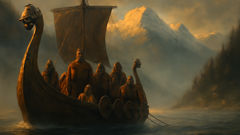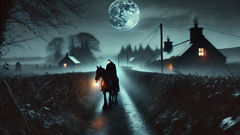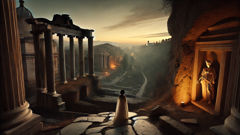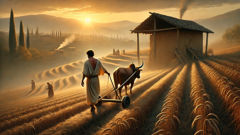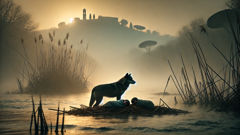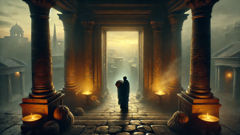Introduction
In the far north, where mountains rise like the spines of sleeping beasts and the sea carves its way through rock and ice, there lies a land wreathed in the wild perfume of pine, brine, and ancient memory. Norway—Heimskringla, the World’s Circle as called by its old poets—has always been a stage for stories as raw and untamed as its landscapes. Before kingdoms and crowns, before the pages of parchment bore the names of kings, there were sagas. These were not mere tales to be recited around fires, but living rivers of memory, carrying the pride, fears, and dreams of a people who shaped their world with sword and song. Into this world, the sagas say, giants once walked, and gods whispered to mortals in the crash of waterfalls and the whisper of birch leaves. But it was human courage and vision that truly forged Norway’s fate. This story, woven from the threads of Snorri Sturluson's legendary Heimskringla but spun anew, takes you from the frost-shrouded days of myth to the first golden rays of a united kingdom. Kings with iron wills and tragic flaws stride across these pages—Odin-blooded Haraldr Hårfagre, haunted Olav Tryggvason, wise Queen Åsa, and the cunning, fierce women and men who stood beside or against them. You’ll witness the forging of alliances in smoky halls, the thunder of battle on snow-blind fields, and the quiet heartbreaks that echo louder than any horn. This is a world where destiny is both fate and choice, and where the courage to rise, to lead, and sometimes to fall is what gives Norway its soul. Prepare to journey through mist and legend, where every fjord hides a secret and every heart a story.
From Giants’ Shadows: The First Kings of the North
Long before the memory of men could be trusted, the land that would become Norway was a wild tapestry of deep woods, glittering lakes, and fjords that sliced through the earth like the scars of ancient battles. The sagas say that giants once strode these lands, shaping valleys with their feet and mountains with their hands, until time and the gods swept them into myth. What remained was a land both beautiful and harsh—demanding strength from those who dared to call it home.
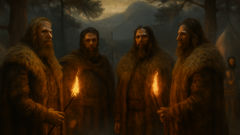
In the age when night could last for months and the aurora danced like lost souls overhead, small clans huddled beneath steep ridges, their fires flickering in the endless dark. Among these people, stories were a lifeline and a legacy. The first king remembered in legend was Fornjót, whose blood was said to run colder than the northern sea. Fornjót was less a man than a force—stoic, sharp-eyed, and hard as granite. He was not crowned but followed, his authority stemming from wisdom and his uncanny ability to read the land’s moods. The people believed he could speak with the winds and had made a pact with the sea itself, which never swallowed his ships nor failed to provide fish for his tables.
But time is as relentless as winter ice. Fornjót’s children inherited not just his rule but the burdens of a changing world. They saw the first stirrings of ambition—a desire not just to survive, but to shape fate itself. Of these heirs, Nór and Gór are most often sung of. Nór, the elder, was a wanderer at heart, drawn always to distant mountains and new horizons. It was he who set out on a journey that became the bones of Norway’s future: gathering clans with words and strength, forging bonds with sword and oath. Gór, in contrast, turned his gaze to the sea, building swift longships and teaching his people to read the secrets of wave and wind.
Under Nór’s leadership, small settlements grew into powerful chiefdoms. Where there had been feuding villages, there were now alliances—often uneasy, sometimes broken by blood, but always reforged in the name of survival. The land itself became a character in these tales: forests that hid both friend and foe, rivers that could flood or freeze at a whim, mountains whose passes demanded bravery from those who sought to cross. The first kings ruled not just men, but the moods of this wild country.
Magic, too, was never far from these early stories. Seers with second sight, wise women who spoke in riddles, and runes carved into bone and bark—these were as much a part of the king’s court as swords and shields. It’s said that Nór’s daughter, Astrid, was born with a storm’s fury in her eyes and could calm wolves with a single word. Though much of her story is lost to time, the memory of her wisdom lingered in the hearts of the people, shaping the way they saw their rulers: not just as warriors, but as keepers of secret knowledge and guides through the darkness.
As generations passed, the kings of the north learned to wield not only the axe but the power of the spoken word. Laws were shaped, not by decree alone but by counsel and contest in smoky halls. The art of storytelling became a tool of kingship—one that united people across valleys and fjords, weaving together the disparate threads of tribe and tongue into something resembling a nation.
Yet, even as these early kings forged unity, they could not escape the pull of destiny and disaster. Rival chiefs, bitter feuds, and the ever-present threat of hunger or plague kept the land in a state of constant tension. It was a world where courage meant more than charging into battle—it was the daily choice to endure, to adapt, and to dream beyond the horizon. This courage, hard-won and handed down like an heirloom sword, would become the bedrock upon which later kings would build their glory and their doom.
Haraldr Fairhair and the Dream of One Kingdom
In the centuries that followed, power ebbed and flowed like the tides. Petty kings ruled their fiefdoms with iron or kindness as suited them, but no one could truly claim all of Norway. That changed when a boy named Haraldr was born under an omen-filled sky, his hair as fair as sunlight on new snow. He would become known as Haraldr Hårfagre—Harald Fairhair—the first to unite Norway under a single crown.
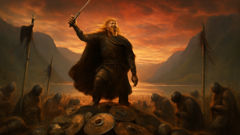
Haraldr’s rise was no accident. He was the child of King Halfdan the Black, a ruler both shrewd and beloved, whose death left a patchwork of loyalties and ambitions. As a youth, Haraldr was said to have an unbreakable spirit—quick to laughter, quicker to anger, but always hungry for something more. The saga tells that he fell in love with Gyda, a proud chieftain’s daughter, who refused his proposal until he ruled all Norway. Spurred by her challenge and his own fierce ambition, Haraldr swore an oath not to cut or comb his hair until he had fulfilled her demand.
It was a vow both foolish and bold. Haraldr’s early years were a whirlwind of battles, alliances, and betrayals. His enemies were many: rival kings who saw him as an upstart, distant cousins with old grudges, even former friends who could not abide the thought of one man ruling all. But Haraldr was relentless. He forged alliances through marriage and gift-giving, yet never shied from open conflict when needed. His greatest asset was not just his sword arm, but his understanding of people—their fears, their dreams, their stubborn pride.
The unification of Norway was a bloody affair. The Battle of Hafrsfjord became legend, a clash where shield walls thundered and the air rang with the song of steel. Haraldr’s warriors, drawn from every corner of the land, fought with the fury of men who knew that this day would decide the fate of generations. When the dust settled, Haraldr emerged victorious. He stood atop a mound of shields, his hair wild and matted as promised, and was hailed as king over all Norway.
True to his word, he summoned Gyda and cut his hair for the first time in ten years. Yet the crown brought new burdens. Many lords resented his rule and sailed west to Iceland or east to serve other kings. Haraldr’s reign was marked by both peace and unrest—a delicate balance between enforcing unity and allowing old freedoms to survive. He established laws, built halls that echoed with song and debate, and encouraged the art of poetry to bind his people together.
But greatness comes at a price. Haraldr grew old in a land he had shaped but could never truly tame. His sons quarreled over inheritance, his enemies watched for weakness, and the question of what it meant to be a king—of land, or of hearts—was never far from his mind. Even so, his legacy endured. Where once there had been only scattered tribes, there was now the glimmer of a nation: proud, fierce, and forever shaped by the courage of one man who dared to dream beyond the bounds of tradition.
The Age of Olaf: Faith, Betrayal, and the Shaping of Norway
As centuries passed, new threats and new hopes emerged. The land was never truly at rest, always shifting beneath the feet of those who claimed to rule it. Among the many kings who followed Haraldr, few cast as long a shadow as Olaf Tryggvason. Born into exile, raised among strangers, and driven by a destiny he could neither embrace nor escape, Olaf’s story is one of faith, betrayal, and transformation.
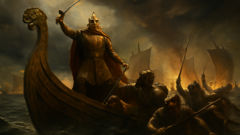
Olaf was descended from royal blood but grew up far from his homeland, taken as a child after his father’s murder. In distant courts and on foreign seas, he learned not only how to fight but how to lead—tempered by loss and longing for home. The sagas say he was fierce but fair, given to moments of deep reflection between bouts of reckless courage. When he returned to Norway as a grown man, it was with an army at his back and a vision in his heart: to unite his country not just by force, but by faith.
The old gods still held sway in Norway, their names whispered in the forests and sung over cups of mead. Olaf brought with him a new creed—Christianity—learned in distant lands but adapted to suit Norse hearts. His mission was as much spiritual as political: to bind Norway together under a single faith, thus strengthening its unity and placing it on equal footing with the great kingdoms to the south.
Not all welcomed this change. Many chieftains clung to Odin and Thor, fearing that abandoning the old ways would anger the spirits of land and kin. Olaf knew this, yet pressed on with a blend of persuasion and force. He built churches where sacred groves had stood, baptized lords in icy rivers, and sometimes resorted to sword or fire when words failed. His charisma was legendary—able to inspire fierce loyalty and bitter hatred in equal measure.
The saga of Olaf is filled with triumphs and heartbreaks. He won many to his cause, yet faced constant rebellion. One of his greatest trials came at the hands of his own kin and former allies, who conspired with foreign powers to bring him down. At the Battle of Svolder, Olaf was betrayed and surrounded at sea. Refusing surrender, he leapt into the waves—his fate unknown, his legacy undimmed.
Olaf’s reign changed Norway forever. Christianity took root, blending with older traditions to create something uniquely Norse. The laws he enacted endured long after his death, shaping the rights and duties of kings and commoners alike. Even those who had fought him could not deny the mark he left on their world. His courage—the willingness to challenge tradition and pay the ultimate price for his vision—echoed through generations.
In the quiet after battle, in the stone churches rising where once had stood only woods, Olaf’s story lived on. He became both saint and sinner in the eyes of his people—a king who had dared to reforge the soul of a nation.
Conclusion
The saga of Norway’s kings is more than a record of battles won and thrones claimed—it is a living memory of a people who shaped themselves in the face of hardship and hope. From the shadowy dawn of myth, through the iron-willed ambition of Haraldr Fairhair and the fiery faith of Olaf Tryggvason, Norway’s story pulses with courage: the courage to change, to endure, and to dream of something greater than oneself. Each generation built upon the bones and dreams of those before, forging a land that is both ancient and ever-renewing. The world they created endures in every forest and fjord, every song and whispered tale. The Heimskringla is not only the story of kings, but of all who walk this northern world—reminding us that greatness often lies in the willingness to embrace both fate and freedom, to stand against the darkness with nothing but hope and the will to endure.

